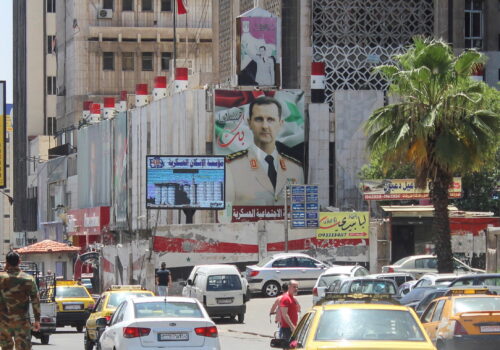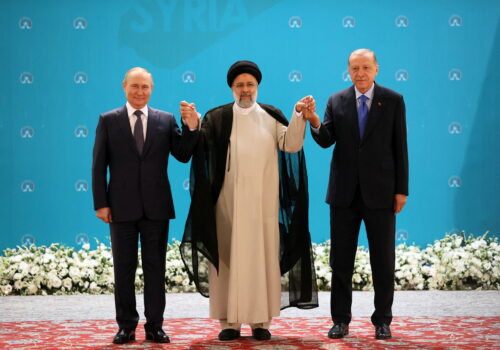Economic recovery in opposition-held Syria is challenging but still possible
The prolonged nature of the Syrian conflict has prompted a paradigm shift by the international community and Syrians, involving early recovery and reconstruction alongside ongoing emergency responses, bypassing a political resolution. This approach addresses the urgent need for local communities to recover from the civil war’s impacts and reestablish livelihoods, while also combating donor fatigue. This shift both reflects changing international priorities in response to global humanitarian crises and challenges efforts toward a political solution.
Economic tools are among the few levers for global and regional actors to extract concessions from the Syrian regime and its foes. However, easing sanctions or normalizing trade with Syria might strengthen Damascus, undermining peace prospects. Also, the alignment of economic recovery goals among different actors complicates efforts. The United States promotes development in northeast Syria but hesitates in northwest Syria. Turkey fosters growth in areas under its influence but opposes northeast Syria normalization. Meanwhile, Russia, Iran, China, some United Nations (UN) agencies, and regional actors reconciled with Damascus and pushed for centralized reconstruction under the Syrian state, seeing it as a unifying force to maintain territorial integrity.
In the meantime, the international community must navigate this complex landscape, balancing local economic recovery while keeping political conversations relevant. This results in a fragmented economic recovery framework lacking cohesion and sustainability. The United States and its allies can foster an early recovery in opposition-held areas without undermining the UN-led political resolution efforts. Critical challenges include addressing stakeholders’ varied interests, ensuring equitable resource distribution, and focusing on sustainable development amid conflict. These strategies are vital for building a resilient economic structure that supports peace and stability, and that serves as a foundation for future diplomatic efforts and the eventual reconstruction of Syria.
Areas of intervention
In the realm of economic recovery in Syria, production-based activities stand out for their relative resilience and minimal taint by the war economy. In comparison, trade, services, and real-estate sectors are dominated by warlords and business cronies due to their easier monopolization, quick returns, and low capital demands. Syria’s agricultural and industrial production has historically benefited from state intervention and protection, mainly in the forms of subsidies and customs laws. Moreover, the Syrian government’s interventionist policies underwent fundamental changes in the last decade before the conflict, with a clear shift toward liberalization and state offloading to the private sector. Mostly, production-based activity was primarily the result of small and medium enterprises’ (SMEs) output and investment by what qualifies as an “independent” business community.
SIGN UP FOR THIS WEEK IN THE MIDEAST NEWSLETTER
The primary objectives of any meaningful economic recovery intervention should be reviving and expanding these production-based activities, rehabilitating their damaged assets, or facilitating their replacement. Specifically, in opposition-held northwest Syria, interventions should target the private sector—businesspeople, entrepreneurs, households, and skilled labor—and the public sector, including local councils, municipalities, and regional governance structures.
The rural character of these areas means that involving the private sector can distribute the benefits of such interventions more broadly, reinforcing the autonomy of local communities relative to armed groups and terrorist organizations. On the other hand, engaging the public sector can democratize access to crucial infrastructure and enable better strategic coordination and planning for local and national development.
Since 2020, the local private sector in northwest Syria has started to invest in production-based activities, establishing new industrial zones, agriculture cooperatives, and thousands of workshops. Thus, support for the private sector should adopt a bottom-up approach and assist at the policy level in navigating challenges in accessing finance, markets, and labor.
However, infrastructure in northwest Syria has historically been poor, a condition exacerbated by the conflict, which saw the destruction of vital assets such as oil-production facilities, electricity-generation plants, and silos for strategic agricultural reserves. Therefore, any international involvement at the infrastructure level must be strategically planned to ensure secure access to these facilities, aiming to enhance production efficiency and eliminate redundancy. This strategic approach is essential to build a foundation that restores functionality and fosters sustainable economic growth in these war-torn regions.
Additionally, the revitalization of these areas could be accelerated by integrating technological advancements into traditional sectors such as agriculture and manufacturing. The regions could increase output efficiency, reduce resource waste, and attract new investments by adopting modern technologies, such as precision farming and automated production lines. Furthermore, international partnerships and funding can be crucial in providing the capital for infrastructure rebuilds and technological upgrades. Emphasizing the importance of sustainability and resilience in these projects can ensure that the recovery efforts are immediate and long-lasting, laying the groundwork for a stable economic future for Syria.
Challenges
The challenges confronting economic recovery before a political settlement in Syria are manifold and complex. One fundamental issue is the risk that initiating economic recovery prematurely could cement the autonomy of various zones of influence and control, potentially making it harder to reunify the country. Despite the well-defined control of multiple factions, cross-frontline trade is significant and growing. However, if this trade does not begin to include services, raw materials, and labor, local economies may seek alternatives that could further entrench division.
Intra-regional trade in Syria, occurring even among staunch enemies, is born out of necessity rather than efficiency or cost-effectiveness. These exchanges often involve smuggling, are laden with high taxation and fees, and carry significant risks, usually falling under the control of warlords and bandits. This makes the trade environment unpredictable and insecure, posing a substantial barrier to the stabilization and growth of a local economy.
Additionally, the economic recovery efforts are hampered by limited and insecure access to finance. In northwest Syria, the absence of a functioning national or international banking sector leaves the local business community with few and unsatisfactory alternatives. Options are typically limited to small grants with stringent conditions provided by the international community, loans and investments by armed groups, or modest foreign-capital investments by the Syrian diaspora that have yet to surpass the level of remittances and family support.
Access to international markets also presents numerous hurdles. Importing raw materials or finished goods into opposition territories may be relatively straightforward and inexpensive, but financing these imports requires complex arrangements involving offshore companies acting as intermediaries. Export challenges include a lack of legal documentation and an irregular supply chain that struggles to handle low-volume shipments or reach the appropriate markets.
Finally, no viable production activity can flourish without skilled labor, and Syria faces compounded challenges in this area. Many skilled workers either emigrated or reside in other territories, and their return or resettlement in Syria would require financial incentives, security, housing, and a basic level of social services. Moreover, during the war vocational training was interrupted or provided at a low skill level. Opposition-held areas desperately lack the institutional educational facilities necessary to train the next generation of technically skilled labor that production industries require to overcome these challenges and scale up production effectively.
These economic hurdles are exacerbated by the overall security situation, which remains volatile and unpredictable across many parts of the country. The lack of a secure environment deters investment and complicates any logistical efforts to rebuild or maintain infrastructure necessary for economic activities. Additionally, the fragmented nature of governance in opposition-controlled areas poses unique challenges for implementing coherent economic policies and programs. Establishing a more stable and cooperative political framework could significantly enhance the efficacy of recovery strategies, leading to more sustainable development outcomes across the region. Addressing these multi-layered challenges requires a coordinated approach that encompasses economic, social, and political dimensions, and ensures that recovery efforts are effective but also equitable and inclusive.
Solutions and policy recommendations
Addressing the challenges of early economic recovery in opposition-held areas in Syria demands a multifaceted strategy that can lay the groundwork for a sustainable and comprehensive international intervention framework. Conceptually, any internationally led economic recovery plan must preserve the potential for a political settlement while respecting Syria’s territorial integrity. This involves preventing exploitation by the Bashar al-Assad regime, warlords and their allies, or affiliated businesses, ensuring high coordination to prevent redundant infrastructure efforts, and fostering connectivity among various zones of influence—or at least encouraging it. Central to the success of such initiatives is the active involvement of SMEs in production-based economies and the local business communities that represent them. The plan must also cleverly design systems that reinforce distributed value chains and engage local communities as partners and sponsors.
Financially, there is potential to broaden access to economic resources through innovative financial services like micro loans and revolving funds, with an expansion of scope and the inclusion of new stakeholders to enhance access for local communities. The United States has encouraged local governance to formulate and enforce banking regulations in northeastern Syria, a process that should be supported with robust governance structures to maintain these policies in other opposition-held areas. The 2022 general license initiated a dialogue among financial institutions about expanding services in opposition-held areas. Further de-risking and initialization would significantly move economic recovery efforts forward and share the financing burden with private actors. Additionally, the Syrian diaspora keenly observes the legal frameworks for private investments, suggesting that the right settings could create investment funds.
On the labor front, there is a critical need for the international community to collaborate with local communities to finance and establish advanced vocational training and educational institutions. These should focus on disciplines essential to a production-based economy, such as engineering, new energy technologies, smart agriculture, and information technology, which are vital for developing a skilled workforce supporting sustainable economic growth.
Navigating the intricate landscape of Syria’s economic recovery demands comprehensive solutions that respect the delicate balance between immediate economic needs and the long-term goal of political stability. By integrating smart financial solutions, fostering skilled labor markets, and ensuring a robust coordination framework, the international community can support Syria in paving a pathway out of conflict and toward sustainable development.
These efforts, while challenging, are essential for establishing a peaceful and prosperous future for Syria, where economic recovery acts not just as a response to immediate needs but as a foundational step toward enduring peace and stability. Enhancing the effectiveness of these efforts requires continuous monitoring and adjustment of strategies to align with evolving on-the-ground realities and stakeholder needs. This dynamic approach can help ensure that recovery initiatives are responsive and adaptive, maximizing their impact and sustainability. Through concerted and well-coordinated actions, the potential for a transformed Syrian society—one that thrives on the principles of equity and inclusivity—becomes more attainable.
Sinan Hatahet is a nonresident senior fellow for the Syria Project at the Atlantic Council’s Middle East Programs and vice president for investment and social impact at the Syrian Forum.
Further reading
Thu, Apr 25, 2024
The Syrian parliamentary elections are coming up. Should anyone care?
MENASource By Vladimir Pran and Maroun Sfeir
The polls will be held again against a backdrop of massive displacement, unresolved conflict, partial occupation, and an intransigent regime.
Thu, May 9, 2024
Syria holds the key to improved US-Turkey ties
MENASource By Ömer Özkizilcik
It is crucial that the United States and Turkey overcome their differences because the governments need to strengthen their alliance—especially as it concerns Syria.
Tue, Feb 20, 2024
Here’s what an uncoordinated US withdrawal from Syria would look like. It’s bad for many partners, but especially Turkey.
MENASource By Ömer Özkizilcik
An uncoordinated withdrawal from Syria by the United States could pose significant risks for Turkey, leaving the country alone against Iran and Russia.
Image: Local Organizations Are Building Housing Projects In Northwest Syria Near The City Of Armanaz In The Countryside Of Idlib, With The Aim Of Reconstructing What Was Destroyed By The Earthquake In The Northwest Syria Region, on February 14, 2024. (Photo by Rami Alsayed/NurPhoto)



